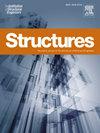基于机器学习的高架钢罐地震响应预测
IF 3.9
2区 工程技术
Q1 ENGINEERING, CIVIL
引用次数: 0
摘要
地震响应分析可评估地震时的结构安全性和完整性,并指导设计以实现最佳性能、符合法规要求和降低风险。本研究提出了一种利用机器学习(ML)技术准确预测高架钢结构储罐地震响应的新方法。ML 是一种功能强大的工具,可以处理复杂性、提高准确性、提供数据驱动的洞察力,并优化预测结构地震响应的设计。此外,本研究还评估了各种 ML 模型,包括随机森林、支持向量回归、自适应提升、LightGBM、基于直方图的梯度提升、XGBoost、CatBoost、袋式回归和决策树,以确定最有效的预测模型。总体而言,所开发的基于 ML 的预测模型为参与高架钢制储罐抗震设计和改造的工程师提供了一种前景广阔的工具,有助于优化设计,提高结构安全性和抗震能力。因此,与其他已开发的模型相比,HGB 模型的性能最合适,具有较高的 R2 和较低的 RMSE。此外,还根据 SHAP 值进行了敏感性分析,发现液体高度和烈度测量是对储罐地震响应影响最大的变量。本文章由计算机程序翻译,如有差异,请以英文原文为准。
Machine learning-based prediction of seismic response of elevated steel tanks
Seismic response analysis assesses structural safety and integrity during earthquakes and guides design for optimal performance, compliance with regulations, and risk mitigation. This study proposes a novel approach utilizing machine learning (ML) techniques to predict the seismic response of elevated steel tanks accurately. ML is a powerful tool that can handle complexity, improve accuracy, provide data-driven insights, and optimize designs for predicting seismic responses of structures. Moreover, this study evaluates various ML models containing Random Forest, Support Vector Regression, Adaptive Boosting, LightGBM, Histogram-based Gradient Boosting, XGBoost, CatBoost, Bagging Regression, and Decision Trees to identify the most effective predictive model. In general, the developed ML-based predictive models provide a promising tool for engineers involved in the seismic design and retrofitting of elevated steel tanks, aiding in optimizing designs and enhancing structural safety and resilience against seismic hazards. As a result, the HGB model obtained the most suitable performance compared to other developed models with higher R2 and lower RMSE. In addition, a sensitivity analysis was performed based on SHAP values, and it was found that the height of the liquid and the intensity measure were the most influential variables in the seismic response of the tank.
求助全文
通过发布文献求助,成功后即可免费获取论文全文。
去求助
来源期刊

Structures
Engineering-Architecture
CiteScore
5.70
自引率
17.10%
发文量
1187
期刊介绍:
Structures aims to publish internationally-leading research across the full breadth of structural engineering. Papers for Structures are particularly welcome in which high-quality research will benefit from wide readership of academics and practitioners such that not only high citation rates but also tangible industrial-related pathways to impact are achieved.
 求助内容:
求助内容: 应助结果提醒方式:
应助结果提醒方式:


